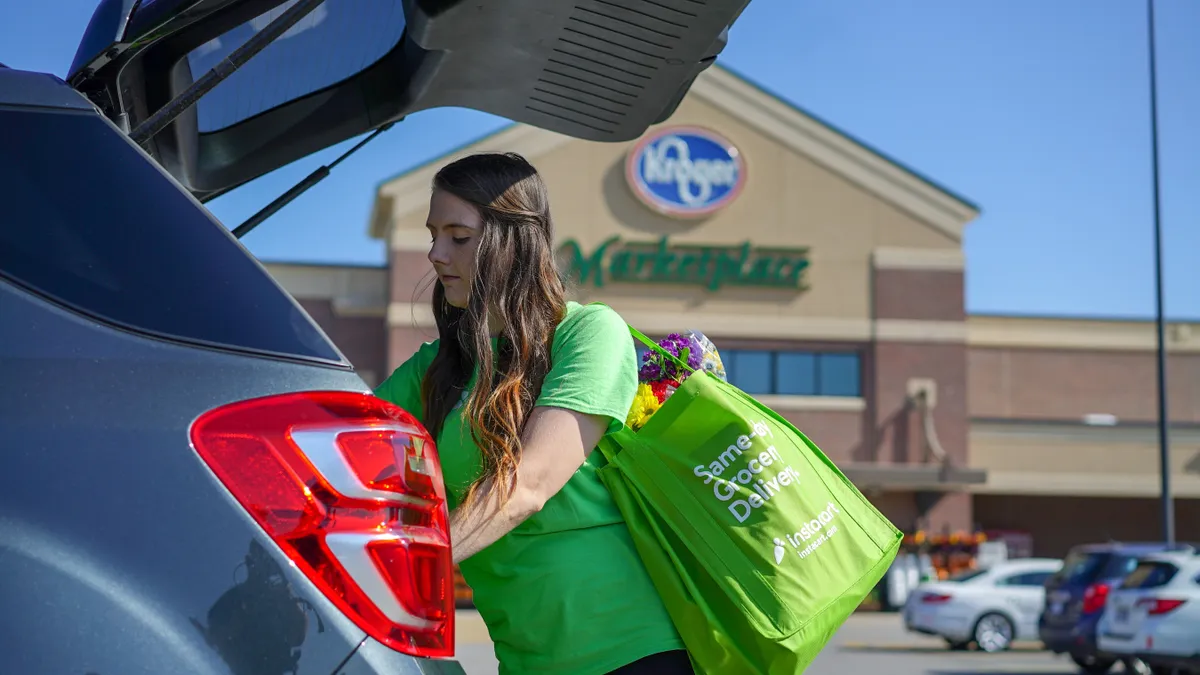Dive Brief:
- Kroger has expanded its same-day grocery delivery services through its partnership with Instacart. The company announced it will add the service to 75 additional markets, including Atlanta, Nashville and Memphis, by late October.
- This expansion will grow Kroger and Instacart’s nationwide footprint by 50%, making the service available at more than 1,600 stores, according to a news release. Kroger and Instacart first announced their partnership in the fall of 2017 and expanded the service in March.
- "We are redefining the customer experience through Restock Kroger by rapidly accelerating our customer coverage area for seamless shopping, giving our shoppers the choice of stores, delivery, curbside pickup or ship to your door," Matt Thompson, Kroger's digital vice president of ClickList, said in the release. "We value our Instacart partnership, and the expansion is just one more way Kroger is offering millions of our customers across America the fresh food and groceries they want, when they want them."
Dive Insight:
The "Amazon effect" seems to be accelerating in the grocery space, as Kroger's aggressive delivery expansion will cover a lot of ground. Shoppers at more than 1,600 Kroger stores will soon be able to summon their groceries to their house in about two hours. The expansion takes Kroger’s delivery service from 45 markets to 120 metropolitan markets. That’s quite a pace, considering Kroger’s first home delivery test was just a year ago.
The expansion is a win for Kroger, which continues to meet consumer needs for convenience while increasing its competitive threat against Amazon and Walmart in the delivery channel. An added benefit to this partnership's expansion is that consumers won't have to leave Kroger's website to facilitate the service. The grocer gets a big advantage of maintaining that one-click convenience and brand consistency without reinventing the backend — Instacart's tech infrastructure makes the orders happen.
It's also a win for Instacart. Thursday's announcement will solidify the delivery company's footprint in 70% of U.S. households. For reference, Amazon has 77% household penetration. In other words, if and when grocery delivery becomes conventional and habitual for consumers, Instacart will be one of the biggest drivers of that behavior.
With the nation's largest grocery store chain prioritizing delivery, it illustrates that we're rapidly barreling toward an on-demand era, where the winners will be determined by what they do outside of their stores as much as what they do in store.
However, a challenge for Kroger will be to stay focused. The company has a lot of balls in the air right now, including a partnership with Ocado's automated warehouses, the elimination of plastic bags, the expansion of its ClickList online ordering/pickup service and a driverless delivery pilot, Scan, Bag, Go.
At a glance, it would seem ClickList and delivery could possibly cannibalize each other and perhaps compromise the company’s investments. But in actuality, these initiatives should complement each other; Kroger uses its ClickList ordering system to facilitate its driverless delivery test and could very well do the same if the Instacart technology is inconsistent. Its partnership with Ocado should help the company keep pace with the added fulfillment obligations from expanding delivery.
Right now, all signs are pointing to consumers wanting a variety of choices – delivery when it’s convenient, pickup on the way home, in-store for spontaneous needs. The online grocery industry is projected to reach $100 billion by 2025, with 70% of consumers expected to shop online, so most, if not all, of Kroger’s investments should eventually pay off. Or, at the very least, Kroger's initiatives should prevent the company from losing convenience-seeking consumers.














